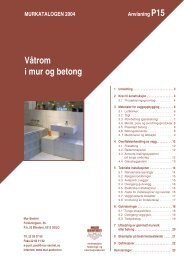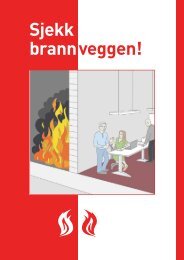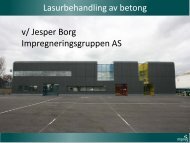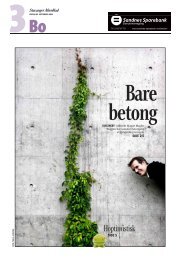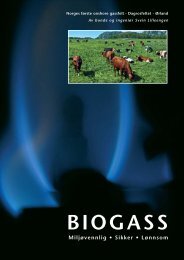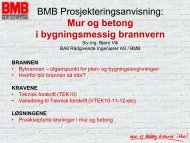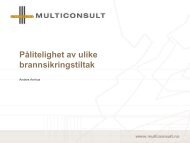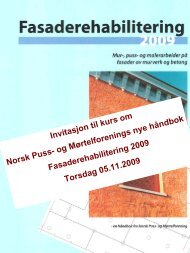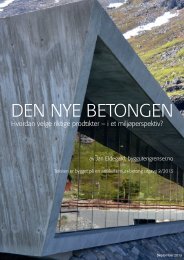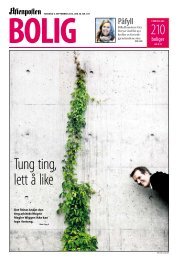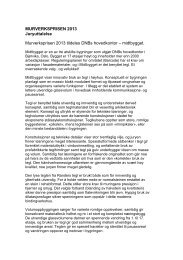Betong for energieffektive bygninger - Betongelementforeningen
Betong for energieffektive bygninger - Betongelementforeningen
Betong for energieffektive bygninger - Betongelementforeningen
Create successful ePaper yourself
Turn your PDF publications into a flip-book with our unique Google optimized e-Paper software.
REFERANSER<br />
ALGARD, ERIK. HØSØIEN, CLAS O 2008. <strong>Betong</strong>elementboka bind E<br />
Isolasjon. <strong>Betong</strong>element<strong>for</strong>eningen, Oslo, Norge<br />
ARUP, 2004. Too hot to handle. Building, No. 6, 2004, London, UK.<br />
ARUP/BILL DUNSTER ARCHITECTS, 2004. UK Housing and Climate<br />
Change – Heavyweight versus lightweight construction, Arup Research &<br />
Development, Bill Dunster Architects, UK.<br />
CIBSE – Chartered Institute of Building Services Engineers, 2005.<br />
Climate change and the Indoor environment: Impacts and adaptation,<br />
TM36, CIBSE, Ascot, UK.<br />
DE SAULLES T, 2005. Thermal mass – a concrete solution <strong>for</strong> a changing<br />
climate. The Concrete Centre, Camberley, UK, 25 pp.<br />
DOKKA T H, 2005. Varmelagringseffekt ved bruk av tunge materialer i<br />
<strong>bygninger</strong>. SINTEF reportSTF 50 A05045, Trondheim, Norge.<br />
EC (2003). DIRECTIVE 2002/91/EC OF THE EUROPEAN PARLIAMENT AND<br />
OF THE COUNCIL of 16 December 2002 on the energy per<strong>for</strong>mance of<br />
buildings. Official Journal of the European Community, Brussels, 2003.<br />
HIETAMÄKI J, KUOPPALA M, KALEMA T og TAIVALANTTI K, 2003.<br />
Thermal mass of buildings – Central researches and their results.<br />
Tampere University of Technology, Institute of Energy and Process<br />
Engineering. Report 2003:174. Tampere, Finland, 43 pp + Annex.<br />
(In Finnish).<br />
CEN, 2005. ISO DIS 13790: 2005. Thermal per<strong>for</strong>mance of buildings –<br />
Calculation of energy use <strong>for</strong> space heating, CEN/TC 89, Brussels,<br />
Belgium.<br />
JOHANNESSON G et al, 2006. Possibility to energy efficient houses by<br />
new integrated calculation approach. ByggTeknik No. 3, Stockholm,<br />
Sweden 2006, 66 pp (In Swedish).<br />
JOHANNESSON G, LIEBLANG P and ÖBERG M. Holistic building design<br />
<strong>for</strong> better energy per<strong>for</strong>mance and thermal com<strong>for</strong>t – opportunities with<br />
the Energy Per<strong>for</strong>mance of Buildings Directive. Submitted in April 2006<br />
to the International Journal of Low Energy and Sustainable Buildings.<br />
Div. of Building Technology, Dept. of Civil and Architectural Engineering,<br />
Royal Institute of Technology, Stockholm, Sweden.<br />
HACKER et al, 2006 Embodied and operational carbon dioxide emissions<br />
from housing: a case study on the effects of thermal mass and climate<br />
change. ARUP Research commissioned by The Concrete Centre and British<br />
Cement Association, UK.<br />
WÆRP, SILJE, 2007. Oppdragsrapport ”Miljømessige aspekter ved bruk<br />
av betong - Kommentarer til “Et klimavennlig Norge” NOU 2006: 18”<br />
SINTEF Bygg<strong>for</strong>sk, Oslo<br />
ÖBERG M, 2005 Integrated life cycle design – Application to Swedish<br />
concrete multi-dwelling buildings, Lund University. Division of Building<br />
Materials, Report TVBM-3103, Lund, Sweden, 117 pp.<br />
19



